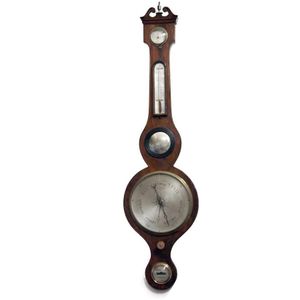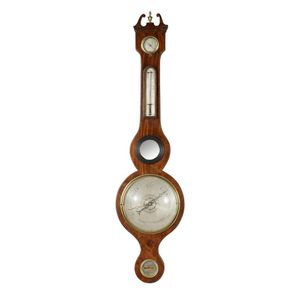George III Banjo Barometer with Silvered Dial
A George III mahogany and boxwood strung banjo barometer, with scroll pedimented top above a silvered hygrometer dial, arched thermometer, ebonised framed convex glass, and an engraved silvered dial, the spirit level inscribed 'Fras.Barnasconi Abergavenny Warranted', height 100.5 cm
You must be a subscriber, and be logged in to view price and dealer details.
Subscribe Now to view actual auction price for this item
When you subscribe, you have the option of setting the currency in which to display prices to $Au, $US, $NZ or Stg.
This item has been sold, and the description, image and price are for reference purposes only.
- Mahogany - Mahogany is a dense, close grained red-coloured timber from the West Indies and Central America. It was first imported into Europe in the the early 18th century and its use continued through the 19th century. It was popular for furniture making because of its strength, the wide boards available, the distinctive grain on some boards, termed flame mahogany and the rich warm colour of the timber when it was polished.. The "flame" was produced where a limb grew out from the trunk of the tree, and this timber was usually sliced into veneers for feature panels on doors, backs and cornices.
Some terms used to describe mahogany relate to the country from which it originally came, such as "Cuban" mahogany, "Honduras" mahogany etc. However unless the wood has been tested the names assigned are more a selling feature, rather than a true indication of the timber's origin. - Boxwood - Boxwood is a hard, yellow coloured, close grained timber. In the 19th century it was often used for inlays, especially stringing, because of its contrasting colour to the darker timbers of the carcase. Stringing is the inlay of a narrow strip of veneer of a lighter colour, such as boxwood along or close to the edges of an object that has been veneered in a darker timber such as mahogany.
Because of its fine grain and resistnce to splitting or chipping it has also been used for treen, turnings, carvings and other small wooden items, such as chess pieces. - George Iii - George III (1738 - 1820) was King of Great Britain and Ireland from 1760 to 1820.
This item has been included into following indexes:
- barometers, period or origin - Georgian, Regency, Sheraton 51
-
barometers, type
- banjo 135
- barometers with thermometer 122
Visually similar items

Wall barometer, banjo, mid 19th century, mahogany
Sold by
in
for
You can display prices in $Au, $US, $NZ or Stg.

Banjo barometer, mahogany case, by Budds Huntingdon, height 95 cm
Sold by
in
for
You can display prices in $Au, $US, $NZ or Stg.

Early Victorian banjo barometer,
Sold by
in
for
You can display prices in $Au, $US, $NZ or Stg.

Victorian Flame Mahogany Wheel Barometer. Silvered hygrometer, thermometer and signed spirit level with a curved base. 98 cm high. 26 wide
Sold by
in
for
You can display prices in $Au, $US, $NZ or Stg.
